Source: Glassnode; Compiled by: Tao Zhu, Golden Finance
Summary
In early January, Bitcoin entered a phase of strong investor distribution, with the cumulative trend score confirming continued seller pressure.
Increased volatility, weak demand, and liquidity constraints have prevented meaningful accumulation from restarting, exacerbating downside risks.
The panic-induced sell-off intensified, with the STH-SOPR surging well below the breakeven level of 1, suggesting that recent buyers are fearful and realizing losses.
The custom SOPR-adjusted CDD indicator we developed shows that the intensity of the sell-off reflects past sell-off events, particularly one in August 2024, when the market plunged to $49,000.
Sell-side pressure remains
Bitcoin’s cyclical behavior is a product of accumulation and distribution phases, where capital rotates between investor groups over time. The Accumulation Trend Score tracks these shifts, with values close to 1 (dark purple) indicating heavy accumulation and values close to 0 (yellow) indicating distribution.
The chart below shows how several accumulation cycles are followed by distribution phases, which have historically led to weaker price action. The latest distribution phase began in January 2025, coinciding with Bitcoin’s sharp correction from $108,000 to $93,000.
The Accumulation Trend Score currently remains below 0.1, indicating that sell-side pressure remains.
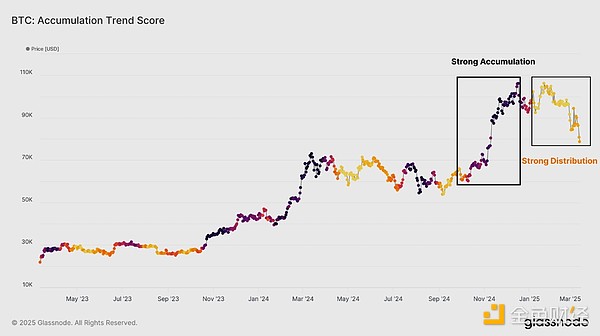
The Accumulation Trend Score measures the relative change in the total on-chain balance. However, it is often influenced by the behavior of larger entities and does not reveal where Bitcoin is being acquired. While it highlights overall accumulation or distribution trends, it lacks the granularity to pinpoint key cost basis levels.
For deeper insights, we can turn to the Cost Basis Distribution (CBD) heat map, which visually shows where supply concentration is forming across different price ranges, helping us identify potential support or resistance areas.
Market participants actively accumulated BTC during the pullback from mid-December to late February, especially in the price range of $95,000 to $98,000. This dip-buying behavior suggests that investors still firmly believe in the bull trend, interpreting the pullback as a temporary pause before further gains.
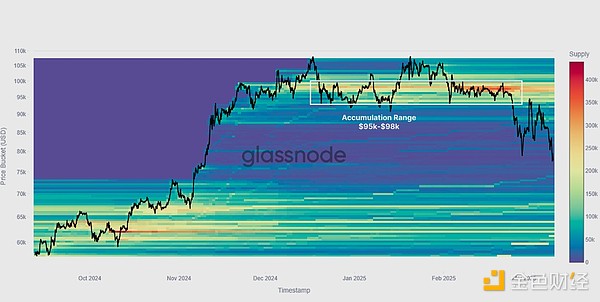
Starting from the end of February, confidence in accumulation began to deteriorate as liquidity conditions tightened. External risk factors, including the Bybit hack and escalating US tariff tensions, have heightened market uncertainty, with Bitcoin’s price falling below $92,000. This level is critical as it reflects the market’s break below the cost basis for short-term holders. Unlike earlier stages, there was no significant dip-buying reaction this time, suggesting that sentiment has shifted toward risk aversion and capital preservation rather than continued accumulation. The CBD heatmap confirms that accumulation demand weakens as macro uncertainty increases, further suggesting that investor confidence is a key driver of accumulation behavior. The lack of dip-buying at lower levels suggests that capital rotation is ongoing, which could lead to a longer consolidation or correction phase before the market can find a solid support base.
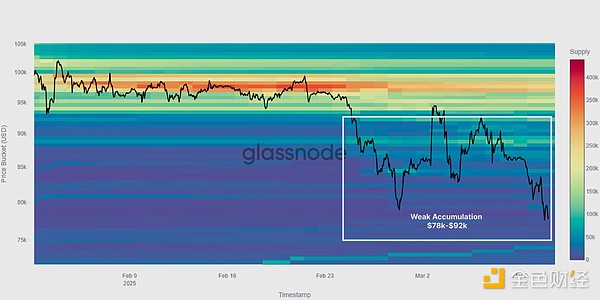
Declining Demand Momentum
We now use the CBD heat map and the Accumulation Trend Score to highlight the lack of substantial accumulation since the end of February. We can dig deeper into this behavior by analyzing the cost basis of two subgroups of Short Term Holders (STHs):
During periods of strong capital inflows, the 1wk-1m cohort’s cost basis is typically higher than the 1m-3m cohort’s cost basis. This suggests that newer investors are purchasing BTC at a relative premium, reflecting bullish sentiment and positive momentum. However, in Q1 2025, this trend begins to level off, marking early signs of weakening demand in the near term.
As the Bitcoin price falls below $95,000, the model also confirms a shift toward net capital outflows as the 1wk-1m cost basis falls below the 1m-3m cost basis. This reversal suggests that macro uncertainty has spooked demand, reducing new inflows and arguably increasing the likelihood of further selling pressure and a prolonged correction.
This shift suggests that new buyers are now unwilling to absorb seller pressure, reinforcing the shift from post-record euphoria to a more cautious market environment.
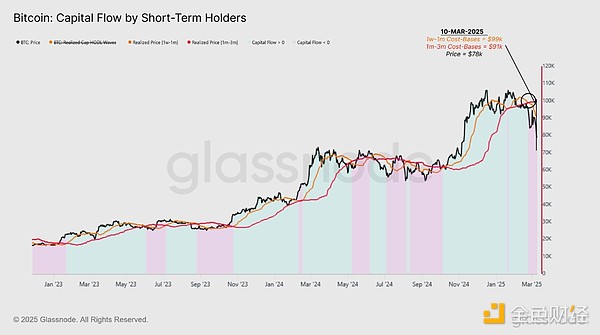
Assessing Fear
As the market enters the post-ATH distribution phase, it becomes critical to assess the level of fear among the short-term holder community, especially those who have recently entered. Understanding the behavior of this community helps market observers identify moments of extreme seller exhaustion, which historically have provided opportunities for long-term investors.
A key metric for this analysis is the Short-Term Holder Spending Output Profit Ratio (STH-SOPR), which measures whether STH is making a profit (SOPR > 1) or a loss (SOPR < 1).
The 196-hour moving average of STH-SOPR has remained below 1 since the price dropped below $95,000, suggesting that most short-term investors are realizing losses. At an extreme point, STH-SOPR dropped to 0.97 as the price plummeted to $78,000, highlighting the severity of the sell-off.
This sustained downward momentum makes new investors nervous, leading to widespread panic selling at losses. This situation often precedes local seller exhaustion, and long-term investors may monitor this dynamic for potential opportunities to re-enter the market.
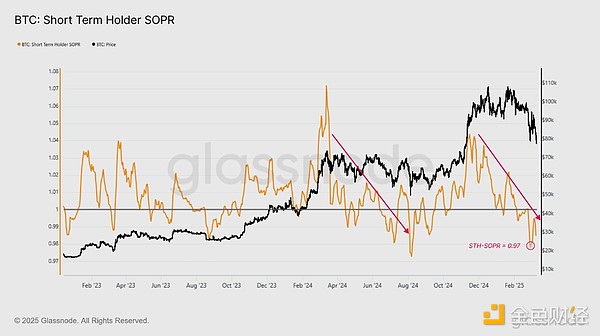
In addition to tracking loss realizations, another key indicator of panic selling is the number of token days destroyed by short-term holders (STH-CDD), which measures the economic weight of tokens spent by new investors by taking into account the number of tokens and the holding period.
During sharp market declines, STH-CDD can spike as investors who are about to become long-term holders panic sell, destroying large amounts of token days. This suggests that short-term holders who previously experienced uncertainty have sold, potentially adding to downward pressure.
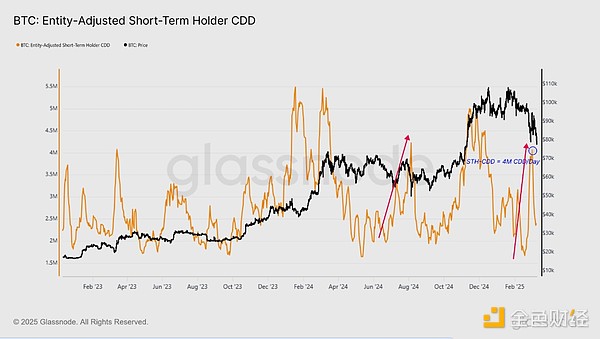
Combining these two concepts, we can construct an indicator that adjusts STH-CDD by incorporating the strength of profit/loss realizations, using the following formula:
(SOPR_STH - 1) * CDD_STH
This indicator refines STH-CDD by weighting the strength and direction of realized profits and losses, providing more precise panic selling signals.
As shown in the chart below, recent selling by top buyers reflects both severe loss realizations and moderate selling events. A similar pattern was seen in August 2024, when Bitcoin plunged to $49,000 amid market stress and macro uncertainty. The current structure suggests a similar sell-off phase.
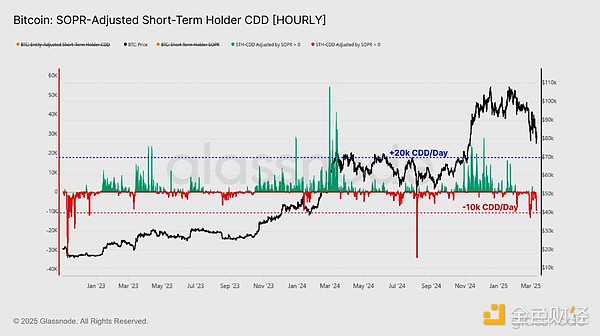
Bear Market Compass
With the selling pressure coming primarily from investors who recently bought into the token at relatively high prices, it becomes sensible to gauge how deep the current bear market might reach. To assess this, we will use various statistical intervals based on the short-term holders’ cost basis as readings for psychological fair value extremes.
The chart below shows the statistical high and low ranges of price deviations derived from these cost basis models.
Currently, the lower bound of the model (where short-term holders are deeply trapped) is between $71,300 and $91,900. Notably, this range coincides with the previously discussed liquidity gap between $70,000 and $88,000, suggesting a strong likelihood of a temporary bottom forming in this area, at least in the short term.
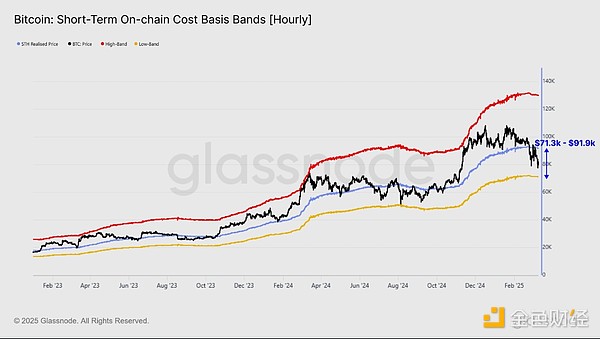
Summary
Bitcoin’s market structure has entered a post-ATH distribution phase, with weak aggregate demand and sustained selling pressure from top buyers in the near term. The Accumulation Trend Score has remained near 0.1 since early January, and the CBD heatmap shows that the buy-on-dip reaction among investors is weakening.
Using the cost basis of short-term holders, we can see that market momentum and capital flows have turned negative, indicating a decline in demand strength and investor uncertainty is affecting sentiment and confidence.
Short-term holders are selling out of fear, as evidenced by the STH-SOPR's continued sub-1 level and the STH-CDD's spike. This localized selling event is also consistent with the market trading toward the lower statistical range, and investors may be experiencing a high degree of financial stress in the near term.
 Kikyo
Kikyo











